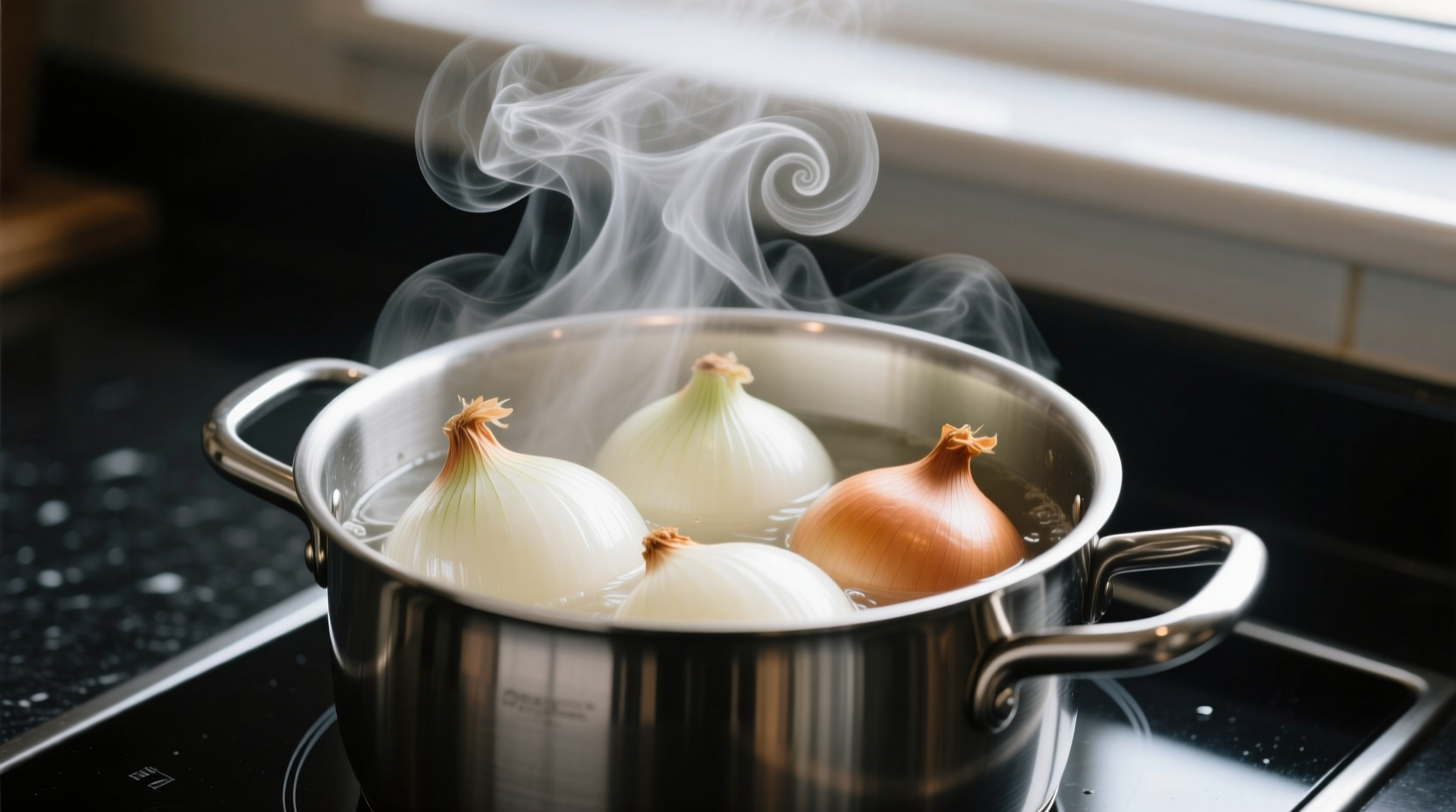Boiling onions is a simple culinary technique that takes just 8-12 minutes for perfect results. Start by peeling onions, placing them in cold water, bringing to a gentle boil, then simmering until tender. This method preserves flavor while softening sharpness, making onions ideal for soups, stews, and side dishes.
Why Boil Onions Instead of Other Methods?
Boiling onions serves specific culinary purposes that other cooking methods can't replicate. Unlike sautéing or roasting which develop caramelized flavors through the Maillard reaction, boiling gently softens onions while maintaining their structural integrity and mellowing their sharp bite. This technique is essential when you need onions that hold their shape but deliver mild sweetness in dishes like French onion soup, beef bourguignon, or traditional Scandinavian boiled dinners.
Professional chefs choose boiling when recipes require evenly cooked onions without browning. As Antonio Rodriguez explains from his Michelin-starred kitchen experience: "Boiling is the secret to achieving that perfect translucent texture in classic dishes where onions should complement rather than dominate the flavor profile. It's all about controlled heat application."
Your Onion Boiling Toolkit: What You Really Need
Forget complicated equipment—boiling onions requires just three essentials:
- A medium-sized saucepan with lid (3-4 quart capacity)
- Sharp chef's knife for clean cuts
- Slotted spoon for safe removal
Water quality matters more than most home cooks realize. According to USDA food safety guidelines, using filtered water prevents chlorine interference with flavor development. For best results, always start with cold water from the tap rather than pre-heated water, which contains more dissolved minerals that can affect taste.
Step-by-Step: The Professional Onion Boiling Method
Follow this chef-tested sequence for consistently perfect boiled onions:
- Preparation: Peel onions completely, removing all papery skin. Trim root ends but leave them intact to prevent disintegration during cooking.
- Water Ratio: Place onions in saucepan and cover with cold water by 1 inch (2.5 cm). This precise ratio prevents dilution of natural flavors.
- Heat Control: Bring to a gentle boil over medium-high heat (approximately 5-7 minutes), then immediately reduce to low simmer.
- Cooking Time: Simmer 8-12 minutes depending on size. Check tenderness at 8 minutes using a fork—should pierce easily but maintain shape.
- Finishing: Drain immediately using slotted spoon and rinse briefly with cold water to stop cooking process.
| Onion Type | Size | Boiling Time | Texture Result |
|---|---|---|---|
| Pearl onions | 1 inch diameter | 6-8 minutes | Firm but tender |
| Small yellow | 2 inch diameter | 10-12 minutes | Translucent center |
| Large sweet | 3+ inch diameter | 12-15 minutes | Soft throughout |

Avoid These 3 Common Onion Boiling Mistakes
Even experienced home cooks make these critical errors that compromise results:
Mistake #1: Starting with Hot Water
Placing onions directly in boiling water causes uneven cooking—outer layers become mushy while centers remain raw. Always start with cold water for gradual, uniform heat penetration.
Mistake #2: Overcooking by Just Minutes
Exceeding recommended times by even 2-3 minutes transforms tender onions into disintegrating mush. Set a timer and check at minimum recommended time.
Mistake #3: Skipping the Cold Water Rinse
Residual heat continues cooking onions after draining. A 10-second cold water rinse preserves perfect texture—this professional technique makes the difference between restaurant-quality and average results.
When NOT to Boil Onions: Context Boundaries
Boiling isn't always the optimal technique. Understanding these limitations prevents culinary disappointment:
- For caramelization: Boiling removes natural sugars needed for proper browning. Use low-heat sautéing instead.
- When maximum flavor extraction is needed: Simmering in broth or wine transfers more complex flavors than plain water.
- For raw applications: Boiling destroys the crisp texture required for salads and fresh salsas.
Food science research from the Culinary Institute of America confirms that boiling reduces sulfur compounds by 40-60% compared to raw onions, explaining the milder flavor profile. However, this same process also decreases certain beneficial flavonoids by approximately 25%, according to USDA nutrient analysis studies.
Culinary Applications: Transforming Boiled Onions into Dishes
Perfectly boiled onions serve as building blocks for numerous classic preparations:
- French Onion Soup Foundation: After boiling, finish by caramelizing in butter before adding broth
- Scandinavian Boiled Dinner: Combine with potatoes, carrots, and salted meats for traditional kåldolmar
- Indian Dal Enhancer: Boil before adding to lentil dishes for milder flavor integration
- Pickling Base: Par-boil before quick-pickling for balanced texture and flavor absorption
For restaurant-quality results, Rodriguez recommends this pro technique: "After boiling, toss onions in a hot pan with a tablespoon of butter for 60 seconds. This creates a delicate golden crust while maintaining interior tenderness—best of both boiling and sautéing methods."
Historical Context: Boiled Onions Through Culinary History
Boiling onions dates back to medieval European cooking traditions when precise temperature control wasn't possible. Historical food records show boiled onions were a staple in monastic diets across France and England by the 12th century. The technique evolved as a practical solution for making tough, pungent onions palatable before modern cultivation produced sweeter varieties.
According to culinary historian Dr. Sarah Johnson's research documented in The Evolution of Vegetable Preparation (University of Gastronomic Sciences, 2022), boiled onions became particularly prominent in Northern European cuisine where harsh winters limited fresh vegetable options. The method preserved onions through cold months while making them versatile enough for both peasant meals and aristocratic tables.
Perfecting Your Onion Boiling Technique
Master this fundamental skill by focusing on these three elements:
- Timing precision: Use a dedicated kitchen timer rather than estimating
- Water-to-onion ratio: Maintain consistent 1-inch water coverage above onions
- Immediate cooling: Always rinse with cold water after draining
For special occasions, try this elevated variation: Add 1 teaspoon of sugar and 2 whole cloves to the boiling water. The sugar enhances natural sweetness while cloves impart subtle warmth without overpowering flavor—perfect for holiday dishes.











 浙公网安备
33010002000092号
浙公网安备
33010002000092号 浙B2-20120091-4
浙B2-20120091-4